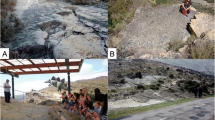Abstract
World Natural Heritage Sites (WNHS) are treasures that need human protection and invite appreciation, which makes conservation of WNHS an urgent task. This paper assesses where in the world threats are most pressing and which WNHS require emergency assistance. Using an analysis of “hot spots” and inverse distance weighting, it finds that Africa is the region where WNHS are least secure. Reports of the state of the conservation of WNHS describe the many threats that exist. Of these, management activities and institutional factors are the primary threats. The paper suggests relevant measures to improve the WNHS security.


Similar content being viewed by others
Notes
World Natural Heritage Sites include natural heritage and mixed heritage identified by the WHC of UNESCO.
References
Al-hagla, S. (2010). Sustainable urban development in historical areas using the tourist trail approach: a case study of the Cultural Heritage and Urban Development (CHUD) project in Saida, Lebanon. Cities, 27(4), 234–248.
Burton, T. A., Smith, S. J., & Cowley, E. R. (2011). Riparian area management: multiple indicator monitoring (MIM) of stream channels and streamside vegetation. Technical Reference 1737–23. BLM/OC/ST-10/003 + 1737 + REV (pp. 155). Denver, CO: U.S. Department of the Interior, Bureau of Land Management, National Operations Center
Courtney, P., Hill, G., & Roberts, D. (2006). The role of Natural Heritage in rural development: an analysis of economic linkages in Scotland. Journal of Rural Studies, 22, 469–484.
Davies, A. J., Roberts, J. M., & Hall-Spencer, J. (2007). Preserving deep-sea natural heritage: emerging issues in offshore conservation and management. Biological Conservation, 138(3–4), 299–312.
De Smith, M. J., Goodchild, M. F., & Longley, P. (2007). Geospatial analysis: a comprehensive guide to principles, techniques and software tools. Winchelsea: Winchelsea Press. http://www.spatialanalysisonline.com
Drost, A. (1996). Developing sustainable tourism for world heritage sites. Annals of Tourism Research, 23(2), 479–484.
Duke, N. C., Bell, A. M., Pederson, D. K., Roelfsema, C. M., & Bengtson Nash, S. (2005). Herbicides implicated as the cause of severe mangrove dieback in the Mackay region, NE Australia: consequences for marine plant habitats of the GBR World Heritage Area. Marine Pollution Bulletin, 51(1–4), 308–324.
Eyre, L. A. (1971). Conceptual models for the geographic analysis of population dynamics in primary communities. Geografiska Annaler. Series B, Human Geography, 53(2), 69–77.
Garrod, B., & Fyall, A. (2000). Managing heritage tourism. Annals of Tourism Research, 27(3), 682–708.
Getis, A., & Ord, J. K. (1992). The analysis of spatial association by use of distance statistics. Geographical Analysis, 24, 189–206.
Graves, P., Atkinson, A., & Goldbach, M. (2006). Travel and transportation management: planning and conducting route inventories. Technical Reference 9113–1, BLM/WO/ST-06/007 + 9113 (pp. 51). Denver, CO: Bureau of Land Management.
Howard, A. J. (2013). Managing global heritage in the face of future climate change: the importance of understanding geological and geomorphological processes and hazards. International Journal of Heritage Studies, 19(7), 632–658.
Jiménez-Sánchez, M., Domínguez-Cuesta, M. J., Aranburu, A., & Martosc, E. (2011). Quantitative indexes based on geomorphologic features: a tool for evaluating human impact on natural and cultural heritage in caves. Journal of Cultural Heritage, 12, 270–278.
Kozlowski, J., & Vass-Bowen, N. (1997). Buffering external threats to heritage conservation areas: a planner’s perspective. Landscape and Urban Planning, 37(3), 245–267.
Leung, Y. F., & Marion, J. L. (1999). Characterizing backcountry camping impacts in Great Smoky Mountains National Park. Journal of Environmental Management, 57(3), 193–203.
Li, M. M., Wu, B. H., & Cai, L. P. (2008). Tourism development of world heritage sites in China: a geographic perspective. Tourism Management, 29(2), 308–319.
Lloyd, D. A. (2003). Dorset GA Group supports multi-national oil industry field excursion to Britain’s first Natural World Heritage Site, 26–29 September 2002. Proceedings of the Geologists Association, 114(2), 173–174.
Maikhuri, K., Nautiyal, S., Rao, K. S., & Saxena, K. G. (2001). Conservation policy–people conflicts: a case study from Nanda Devi Biosphere Reserve (a World Heritage Site), India. Forest Policy and Economics, 2(3–4), 355–365.
Nursey-Bray, M., & Rist, P. (2009). Co-management and protected area management: achieving effective management of a contested site, lessons from the Great Barrier Reef World Heritage Area (GBRWHA). Marine Policy, 33(1), 118–127.
Osti, M., Coad, L., Fisher, J. B., Bomhard, B., & Hutton, J. M. (2011). Oil and gas development in the World Heritage and wider protected area network in sub-Saharan Africa. Biodiversity and Conservation, 20(9), 1863–1877.
Overmars, K. P., & Verburg, P. H. (2005). Analysis of land use drivers at the watershed and household level: linking two paradigms at the Philippine forest fringe. International Journal of Geographical Information Science, 19(2), 125–152.
Patry, M., Bassett C., & Leclerq B. (2005). The state of conservation of World Heritage forests. United Nations Educational, Scientific and Cultural Organization.http://whc.unesco.org/uploads/activities/documents/activity-43-2.pdf. Accessed 15 January, 2013.
Ross, A., Rowan-Robinson, J., & Walton, W. (1995). Sustainable development in Scotland: the role of Scottish Natural Heritage. Land Use Policy, 12(3), 237–252.
Sekercioglu, C. H., Anderson, S., Akçay, E., & Bilgin, R. (2011). Turkey’s rich Natural Heritage under assault. Science, 334(6063), 1637–U1638.
Shackley, M. (Ed.). (1998). Visitor management: case studies from World Heritage Sites (pp. 46–65). Oxford: Butterworth-Heinemann.
Su, M. M., & Li, B. (2012). Resource management at World Heritage sites in China. Procedia Environmental Sciences, 12, 293–297.
Topay, M. (2007). The importance of climate for recreational planning of rural areas; case study of Muğla Province, Turkey. 3rd International Workshop on Climate, Tourism and Recreation, 19–22.
UNESCO. (1972). Convention concerning the protection of the World Cultural and Natural Heritage. Paris: United Nations Educational Scientific and Cultural Organization. http://whc.unesco.org/en/conventiontext/. Accessed 15 January, 2013.
UNESCO. (2013). Operational guidelines for the implementation of the World Heritage Convention. World Heritage Centre. http://whc.unesco.org/en/guidelines/. Accessed 15 January, 2013.
Verburg, P. H., Veldkamp, W. S. A., Espaldon, R. L. V., & Mastura, S. S. A. (2002). Modeling the spatial dynamics of regional land use: the CLIE-S model. Environmental Management, 30(3), 391–405.
Wager, J. (1995). Developing a strategy for the Angkor World Heritage site. Tourism Management, 16(7), 515–523.
Wang, Y. (2012). Management of the Grand Canal and it’s [sic] bid as a World Cultural Heritage site. Frontiers of Architectural Research, 1(1), 34–39.
Wyman, S., Bailey, D., Borman, M., Cote, S., Eisner, J., Elmore, W., et al. (2006). Riparian area management: grazing management processes and strategies for riparian-wetland areas (Technical Reference 1737–20. BLM/ST/ST-06/002+1737 (pp. 105). Denver, CO: U.S.). Bureau of Land Management, National Science and Technology Center: Department of the Interior.
Xu, J. P., Yao, L. M., & Mo, L. W. (2011). Simulation of low-carbon tourism in World Natural and Cultural Heritage areas: an application to Shizhong District of Leshan City in China. Energy Policy, 39(7), 4298–4307.
Zimmerman, D., Pavlik, C., Ruggles, S., & Armstrong, M. P. (1999). An experimental comparison of ordinary and universal kriging and inverse distance weighting. Mathematical Geology, 31, 375–390.
Acknowledgments
Based on the data obtained from the WHC, the security of WNHS in the world was analyzed in this paper. We appreciate the work that the WHC has been doing to protect the WHS, and we thank the WHC sincerely. This paper is sponsored by the National Natural Science Foundation of China (41301163) and its program sponsoring doctors in the western region of the Chinese Academy of Sciences (XBBS201210). We also appreciate the suggestions of all anonymous reviewers.
Author information
Authors and Affiliations
Corresponding author
Rights and permissions
About this article
Cite this article
Wang, Z., Yang, Z. & Du, X. Analysis on the threats and spatiotemporal distribution pattern of security in World Natural Heritage Sites. Environ Monit Assess 187, 4143 (2015). https://doi.org/10.1007/s10661-014-4143-5
Received:
Accepted:
Published:
DOI: https://doi.org/10.1007/s10661-014-4143-5




